Baal Shem Tov
Baal Shem Tov | |
|---|---|
| Personal | |
| Born | Yisroel ben Eliezer 1698 Okopy Świętej Trójcy,Kingdom of Poland(now Ukraine) |
| Died | 22 May 1760 (6 Sivan 5520) Międzybóż,Kingdom of Poland (now Ukraine) |
| Religion | Judaism |
| Spouse | Ḥanah[1] |
| Children |
|
| Parents |
|
| Signature | |
| Jewish leader | |
| Successor | Dov Ber of Mezeritch(1704–1772) |
Israel ben EliezerorYisroel ben Eliezer(1698[2]– 22 May 1760), known as theBaal Shem Tov(/ˌbɑːlˈʃɛmˌtʊv,ˌtʊf/;[3]Hebrew:בעל שם טוב) or as theBeShT,was aJewish mysticand healer who is regarded as the founder ofHasidic Judaism.[4]"Besht" is theacronymforBaalShemTov, which means "Master of the Good Name," a term for a holy man who wields the secret name of God.[5]
The little biographical information about the Baal Shem Tov comes from oral traditions handed down by his students (Jacob Joseph of Polonneand others) and from the legendary tales about his life and behavior collected inShivḥei ha-Besht(In Praise of the Ba'al Shem Tov;KapustandBerdychiv,1814–15).[6]
A central tenet in the Baal Shem Tov's teaching is the direct connection withthe divine,"dvekut", which is infused in every human activity and every waking hour. Prayer is of supreme importance, along with the mystical significance of Hebrew letters and words. His innovation lies in "encouraging worshippers to follow their distracting thoughts to their roots in the divine."[7]
Biography[edit]
Early years[edit]
Yisroel (Israel) was born to poor parents Eliezer and Sarah in a settlement nearOkopy, Ternopil Oblast,a newly built fortress close toKameniecinWest Ukraine,whereZbruchconnects withDniester.Today, Okopy is a village inChortkiv Raion(district)ofTernopilOblast.
In 1703, Israel became an orphan, and was adopted by the Jewish community ofTluste(nearZalischyky). It is reported that, after the conclusion of his studies at the localcheder(Jewish elementary school), he would often wander into the fields and forests that surrounded the village. In 1710, he finishedchederand became an assistant to amelamed(instructor incheder). In 1711 at the age of 13/14 he entered the "Chaburas Machane Yisroel", a group of hiddentzaddikimled by RabbiAdam Baal Shem.Sometime in 1712 Israel became ashammash(sexton) of the local synagogue.
He was hired as a teacher's assistant in thechedersof the small villages through which they passed. He later related that he took great pleasure in accompanying the children to and from school, using this opportunity to recite prayers with them and tell them Torah stories. The Mezritcher Maggid, the Baal Shem Tov's successor, would later say, "If only we kissed a Torah scroll with the same love that my master [the Baal Shem Tov] kissed the children when he took them to cheder as a teacher's assistant!"[8]
According to Hasidic legend, the Baal Shem Tov would have visions in which the prophetAchiya Hashiloniwould appear to him.[2]In 1716 the Baal Shem Tov married, but soon his wife died and he went on travelling throughoutEastern Galicia.After serving for a long time as a helper in various small communities ofWest Ukraine,he settled as amelamedat Tluste.
The Besht was introduced toKabbalahby RabbiAdam Baal ShemofRopczyce(Yiddish:ראָפּשיץ) who was a disciple of RabbiYoel Baal Shem (I)ofZamość(Yiddish:זאמושטש), the successor of Rabbi Eliyahu Baal Shem ofWorms(Yiddish:ורמיזא, ורמישא).[9]
The Besht became the leader of this movement at the age of 18.[10]Caring for the Jewish poor, the group of Tzadikim encouraged Jews to move to agrarian lifestyles as alternatives to the chronic poverty of city Jews. In continuation of this policy, they decided that they needed to look after the educational needs of the children living in small farm communities. If a suitable teacher could not be sourced they themselves would provide one, and therefore the Baal Shem Tov became a teacher's assistant. He later commented "The most joyous time in my life was teaching the small children how to say Modeh Ani, Shema Yisrael and Kametz Alef Ah".[11]
He was chosen by people conducting suits against each other to act as theirarbitratorandmediator.His services were brought into frequent requisition because the Jews had their owncivil courtsin Poland. He is said to have made such an impression onEphraimofBrodythat the latter promised the Besht his daughter Chana in marriage. The man died, however, without telling his daughter of her betrothal; but when she heard of her father's wishes, she agreed to comply with them.[4]
After their marriage, the couple moved to a village in theCarpathiansbetweenKutyandKassowa,[4]where their only income was from his work diggingclayandlime,which his wife delivered to surrounding villages. The couple had two children: Udl (born in 1720) and Zvi Hersh. A maternal great-grandson of Baal Shem Tov and his wife was RebNachman of Breslovwhose paternal ancestry came from (according to Hasidic tradition), theMaharal's family descendedpatrilineallyfrom the Babylonian Exilarchs (during the era of thegeonim) and therefore also from theDavidic dynasty.[12]
Leadership[edit]
The Besht later took a position as ashohet(ritual butcher) inKshilowice,nearIaslowice,which he soon gave up in order to manage a village tavern that his brother-in-law bought for him. His first appearance in public was that of an ordinaryBaal Shem,a faith-healer who wroteamuletsand prescribed cures,[4][13][14]functioning as a type of shaman.[15][16]
After many trips inPodoliaandVolhyniaas a Baal Shem, Besht, considering his following large enough and his authority established, decided about 1740 to expound his teachings in theshtetl(Jewish village) ofMedzhybizhand people, mostly from the spiritual elite, came to listen to him. Medzhybizh became the seat of the movement and of theMedzybizh Hasidic dynasty.His following gradually increased and with it the hostility of the Talmudists. The Besht was supported at the beginning of his career by two prominent Talmudists, the brothers Meïr (chief rabbiofLembergand laterOstroha,and author ofMeir Netivim(a work of halachic responsa) and other works) and Isaac Dov Margalios. Later he won over recognized rabbinic authorities who became his disciples and attested to his scholarship. These include RabbiYaakov Yosef Hakohen,rabbi ofPolnoy;Rabbi Dovid Halperin, rabbi of Ostroha; Rabbi Israel ofSatinov,author ofTiferet Yisrael;Rabbi Yoseph Heilperin of Slosowitz; and RabbiDov Ber of Mezrich(AKA theMaggid of Mezritch). It is chiefly due to the latter that Besht's doctrines (though in an essentially altered form) were introduced into learned Jewish religious circles.[4]
Israel undertook journeys in which he is recorded as effecting cures and expelling demons and evil spirits (shedim). Later Hasidic tradition, however, downplayed the importance of these healing and magical practices, concentrating on his teachings, his charm, magnetism, and ecstatic personality.[17]
The "Agudas Ohalei Tzadikim"[18]organization (based in Israel) has restored many graves ofTzadikim(Ohelim) in Ukraine, including the Baal Shem Tov's. A guesthouse and synagogue are located next to theOhelof Baal Shem Tov, and the Baal Shem Tov's synagogue in the village proper has been painstakingly restored. Both synagogues are used by the many visitors from all over the world.
Disputes with the Frankists and death[edit]
The Besht took sides with the Talmudists in their disputes against the Frankists (Jacob Frank's cultist movement which regarded Frank as theMessiah,modelled afterSabbatai Zevi.) After the mass conversion of the Frankists, the Baal Shem Tov allegedly said that as long as a diseased limb is connected with the body, there is hope that it may be saved; but, once amputated, it is gone, and there is no hope.[19]It is alleged that he died out of grief that the Frankists left Judaism.[20]
He died inMedzhybizh,[4]which was part ofPoland(today in theKhmelnytskyiOblast,Ukraine).[21]
Legacy[edit]
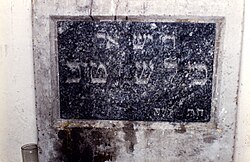
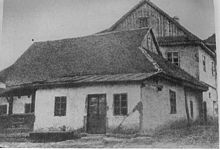
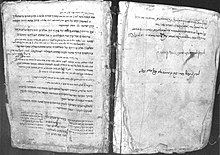
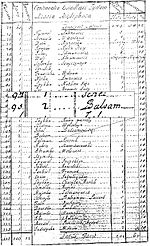
Israel ben Eliezer left no books; for theKabbalisticcommentary on Psalm 107, ascribed to him (Zhitomir,1804),Sefer mi-Rabbi Yisrael Baal Shem-tov,may not be genuine. Therefore, the most reliable record of his teachings is in his utterances as recorded in the works of his disciples (Hasidim). Most are found in the works of Rabbi Jacob Joseph of Polnoy. But since Hasidism, immediately after the death of its founder, was divided into various parties, each claiming for itself the authority of Besht, the utmost of caution is necessary for judging as to the authenticity of utterances ascribed to Besht.[4]
Rabbi Jacob Joseph quotes over eight hundred teachings of his Master the Besht, in his books. In some rare quotes, Rabbi Jacob Joseph states that he's not sure if these particular quotes are the 'exact' words of the Baal Shem Tov. This seems to shows that all other quotes he repeats, are the 'exact words' he heard from his master. We therefore essentially have a full book of reliable authentic teachings of the Baal Shem Tov, relayed meticulously in the 'exact words' as heard directly from his mouth. This is the most powerful direct historical evidence of the Besht.
Some other direct historical evidence remains of the Besht during the days he lived in Medzhybizh. Rosman discovered numerous legal documents that shed light on this period from the PolishCzartoryskinoble familyarchives. The Besht's house is mentioned on several tax registers where it is recorded as having tax-free status. Several of the Besht's colleagues in his stories from Shivhei HaBesht also appear in Polish court records, notably,Ze'ev Wolf Kitzesand Dovid Purkes. Rosman contends that the Polish documents show the Besht and his followers were not outcasts or pariahs, but rather a respected part of mainstream Jewish communal life.
Otherdirect evidenceincludes the Besht's daily prayer-book (siddur,owned by the Agudas Chabad Library in New York) with his handwritten personal notes in the margins. His grave can be seen today in the old Jewish cemetery in Medzhybizh.
Chapin and Weinstock contend that the Besht was essentially the right person, in the right place, at the right time. 18th centuryPodoliawas an ideal place to foster a sea-change in Jewish thinking. It had been depopulated one generation earlier due to theKhmelnitskyMassacres. A Turkish occupation of Podolia occurred within the Besht's lifetime and along with it the influence within this frontier territory ofSabbatai Zeviand his latter day spiritual descendants such as Malach andJacob Frank.Once the Polish Magnates regained control from the Turks, Podolia went through an economic boom. The Magnates were benevolent to the economic benefits the Jews provided, and encouraged Jewish resettlement to help protect the frontier from future invasions. Thus, the Jewish community itself was essentially starting over.
Practices[edit]
The Besht was a mystic who claimed to have achieveddevekut( "adhesion" ), meaning that his soul had reached the high level where he could "ascend" to heaven and speak with any soul in heaven that he wished to speak to (though his only recorded choice was of the Messiah, and only once), and intervene between humans and God. He had the ability to protect the Jewish community from plague and persecution.[22]He did this through prayer.
According to a letter from the Besht's brother-in-law to the Besht himself—as interpreted byMoshe Rosman— the latter was a practitioner of prophecy, being able to see a messianic figure arrive in Jerusalem despite living far from the city; the brother-in-law claims to have inquired into the figure and discovered the Besht's vision to be true. This claim also supports the supposed belief that the Besht had the ability to see the souls of men, divining the messianic quality of the man despite only seeing him through a vision. Rosman also describes another letter written by the brother-in-law which claims that the Besht could travel to heaven and commune with God. This view is derived from a series of titles given to the Besht, attributing various religious achievements to him such as understanding the mysteries of God. Similarly, Rosman—though now citing the writings of a Polish rabbi—says that it was believed the Besht was a great medical practitioner with vast knowledge regarding salves, balms, and similar medicants. Some aspects of his medical practice are said to have been mystic in nature, though the degree to which this is the case is not agreed upon. Some claim[like whom?]that the Besht could only heal others through prayer and similar acts: recitation of holy words. In other works, he is said to have fewer limitations on his supposed ability, allowing for more mystic methods to be practised.[23]
He atefarfeleveryFriday nightbecause the word was similar to the worldfarfalenwhich means "wiped out, over and finished". He considered the noodles a symbol marking the beginning of a new week.[24]
Core doctrines[edit]

The Besht's concept of thezaddikis of the existence of superior individuals whose spiritual qualities are greater than those of other human beings and who are outstanding in their higher level ofdevekut.These individuals influence society, and their task is to teach the people to worship God by means ofdevekutand to lead sinners to repent.[25]
Influence on Hasidism[edit]
The later developments of Hasidism are unintelligible without consideration of Besht's opinion concerning man's proper relation with the universe. True worship of God consists of the cleaving to, and the unification with, God. To use his own words, "the ideal of man is to be a revelation himself, clearly to recognize himself as a manifestation of God." Mysticism, he said, is not the Kabbalah, which everyone may learn; but that sense of true oneness, which is usually as strange, unintelligible, and incomprehensible to mankind as dancing is to a dove. However, the man who is capable of this feeling is endowed with a genuine intuition, and it is the perception of such a man which is called prophecy, according to the degree of his insight. From this it results, in the first place, that the ideal man may lay claim to authority equal, in a certain sense, to the authority of the Prophets.[4]This focus on oneness and personal revelation help earn his mystical interpretation of Judaism the title ofPanentheism.
A second and more important result of the doctrine is that through his oneness with God, man forms a connecting link between the Creator and creation. Thus, slightly modifying the Bible verse,Hab.2:4,Besht said, "The righteous can vivify by his faith." Besht's followers enlarged upon this idea and consistently deduced from it the source of divine mercy, of blessings, of life; and that therefore, if one loves him, one may partake of God's mercy.[4]
On the opposite side of the coin, the Baal Shem Tov warned the Hasidim:
- Amalekis still alive today… Every time you experience a worry or doubt about how God is running the world—that's Amalek launching an attack against your soul. We must wipe Amalek out of our hearts whenever—and wherever—he attacks so that we can serve God with complete joy.
It may be said of Hasidism that there is no other Jewish sect in which the founder is as important as his doctrines. Besht himself is still the real center for the Hasidim; his teachings have almost sunk into oblivion. AsSchechter( "Studies in Judaism,"p. 4) observes:" To the Hasidim, Baal-Shem [Besht]... was the incarnation of a theory, and his whole life the revelation of a system. "[4]
Teaching methods[edit]
Besht did not combatrabbinical Judaism,but the spirit of its practice. His teachings being the result of a deep, religious temperament, he stressed the spirit. Though he considered the Law to be holy and inviolable, and he emphasized the importance of Torah-study, he held that one's entire life should be a service of God.[4]Hasidic legend tells of a woman whom her relatives sought to kill on account of her shameful life, but who was saved in body and soul by Besht. The story is said to be characteristic of Besht's activity in healing those in need of relief. More important to him than prayer was a friendly relationship with sinners. Unselfishness and high-minded benevolence are a motif in the legends about him.[4]
Besht's methods of teaching differed from those of his opponents. He directed many satirical remarks at them, a characteristic one being his designation of the typical Talmudist of his day as "a man who through a sheer study of the Law has no time to think about God". Besht is reported to have illustrated his views of asceticism by the following parable:
- A thief once tried to break into a house, the owner of which, crying out, frightened the thief away. The same thief soon afterward broke into the house of a very strong man, who, on seeing him enter, kept quite still. When the thief had come near enough, the man caught him and put him in prison, thus depriving him of all opportunity to do further harm.[4]
Besht held a firm conviction that God had entrusted him with a special mission to spread his doctrines. He believed that he had heavenly visions revealing this mission to him. For him, every intuition was adivine revelation,and divine messages were daily occurrences.[4]An example of the power of his spiritual vision is found at the beginning of his grandson's work,Degel,where he writes that his grandfather wrote toGershon Kitoverwho lived in Israel, asking him why he was not in Israel that particularShabbos.
Legends[edit]
The world makes three errors by thinking that telling stories of the Baal Shem Tov onMotzei Shabbatensures one’s livelihood. First of all, these stories are not to be limited to the Baal Shem Tov, but should include tales of all ourTzaddikim.Secondly, they should not be told only after but at any time. And lastly, telling these stories not only ensures livelihood, but serves as aSegulahto ensure we receive an abundance of blessings relating to our children, good health and success in our livelihood
— Maharash
In Hasidic tradition, there's a saying, "Someone who believes in all the stories of the Baal Shem Tov and the other mystics and holy men is a fool; someone who looks at any single story and says, 'That one could not be true' is a heretic."[26]
According to theEncyclopaedia Judaicathe number of legends that are told relating to the Ba'al Shem Tov have 'distorted his historical character.'[25]An anthology of legends about him was first compiled byDov Baer b. SamuelofLinits,who was the son-in-law of Alexander Shoḥat, who had acted for several years as the Besht's scribe. The collection was copied many times and over time it became filled with errors. It was printed with the title,Shivḥei ha-Beshtafter Dov Baer's death. It was published by Israel Jaffe who rewrote the first chapter and removed what he considered to be the distortions caused by copyists.
This edition, printed in Kopys (Kapust) in 1814, contains 230 stories grouped by common themes, characters, and motifs. Two editions also appeared in Yiddish that differ markedly from the Hebrew edition.
In the 19th century several further collections of legends about the Ba’al Shem Tov, and his followers appeared, in Hebrew and Yiddish, some of which repeated stories found inShivḥei ha-Beshtand some of which contained new stories. According to theEncyclopaedia Judaicaonly a few of these stories can actually be regarded as true.[27]
One legend tells that his father, Eliezer, was seized during an attack, carried from his home inWallachia,and sold as a slave to a prince. On account of his wisdom, he found favor with the prince, who gave him to the king to be his minister. During an expedition undertaken by the king, when other counsel failed, and all were disheartened, Eliezer's advice was accepted; and the result was a successful battle of decisive importance. Eliezer was made ageneraland afterwardprime minister,and the king gave him the daughter of the viceroy in marriage. But being mindful of his duty as a Jew and as he was already married, he married the princess only in name. After being questioned for a long time as to his strange conduct, he confessed to the princess that he was a Jew, who loaded him with costly presents and helped him escape to his own country.[4]
On the way, the prophetElijahis said to have appeared to Eliezer and said: "On account of thy piety and steadfastness, thou wilt have a son who will lighten the eyes of all Israel; and Israel shall be his name because in him shall be fulfilled the verse (Isaiah49:3): 'Thou art my servant, O Israel, in whom I will be glorified.' "Eliezer and his wife Sarah, however, reached old age childless and had given up all hope of ever having a child. But when they were nearly a hundred years old, the promised son (Besht) was born.[4]
-
Baal Shem Tov’s shul reconstructed (as a museum); August 4, 2008
-
Ohel of Baal Shem Tov; August 4, 2008
-
New guesthouse and synagogue next to Ohel of Baal Shem Tov (work in progress); August 4, 2008
Notable students[edit]
The Baal Shem Tov directly imparted his teachings to his students, some of whom founded their own Hasidic dynasties.
- Yaakov Yosef of Polonoy(1710–1784)
- Ze'ev Wolf KitzesofMedzhybizh(~1685–1788)
- Yechiel Michel ofZlotchov(1721–1786)
- Dov Ber of Mezeritch(1704–1772) traced to King David by way ofRabbi Yohanan,the sandal-maker and master in the Talmud
- Pinchas ofKorets(1728–1790)
- Nachum TwerskiofChernobyl(1730–1797) founder of theChernobyl Hasidic dynasty
- Leib ofShpola(1725–1812)
- RabbiAbraham Gershon of Kitov(Kuty), brother-in-law of The Baal Shem Tov (1701–1761); descendant (possibly the grandson) ofShabbatai ha-Kohen( "the ShACh" ) (1625–1663)
- Moshe Chaim Ephraim of Sudilkov(1748–1800) (his grandson)
- Boruch of Medzhybizh(1753–1811) (his grandson)
- Meir Hagadol ofPremishlan(1703–1773)
- Nachman of Horodenka(d. 1765)
Confusion with Baal Shem of London[edit]
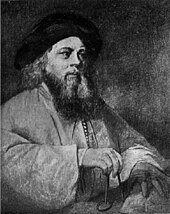
A portrait byJohn Singleton Copleyoften mistaken for the Baal Shem Tov is really a portrait of Hayyim Samuel Jacob Falk, who was known as theBaal Shem of London.[28]
In popular culture[edit]
In 2019, the American funk quartetThe Fearless Flyersreleased an instrumental single named "The Baal Shem Tov" in honor of the rabbi.[29][30]
SingerMatisyahu's song Baal Shem Tov on the albumSpark Seekeris named after him.
He was portrayed byLuzer Twerskyin the Ukrainian filmDovbush(2023).
See also[edit]
References[edit]
- ^https://yivoencyclopedia.org/article.aspx/Baal_Shem_Tov:"His wife, Ḥanah, was a divorcée"
- ^abGolding, Peretz."The Baal Shem Tov—A Brief Biography – Jewish History".Chabad.org.Retrieved2013-03-12.
- ^Jones, Daniel(2003) [1917], Peter Roach; James Hartmann; Jane Setter (eds.),English Pronouncing Dictionary,Cambridge: Cambridge University Press,ISBN3-12-539683-2
- ^abcdefghijklmnop
 One or more of the preceding sentences incorporates text from a publication now in thepublic domain:Singer, Isidore;et al., eds. (1901–1906)."BA'AL SHEM-ṬOB, ISRAEL B. ELIEZER".The Jewish Encyclopedia.New York: Funk & Wagnalls.
One or more of the preceding sentences incorporates text from a publication now in thepublic domain:Singer, Isidore;et al., eds. (1901–1906)."BA'AL SHEM-ṬOB, ISRAEL B. ELIEZER".The Jewish Encyclopedia.New York: Funk & Wagnalls.
- ^p. 409,The Light and Fire of the Baal Shem Tov,Yitzhak Buxbaum. New York: Continuum International Publishing Group, 2006.
- ^ Encyclopaedia Judaica,Second Edition, Volume 10, p. 743, Avraham Rubinstein
- ^ The brilliance of the Baal Shem Tov now in English,Haaretz.
- ^Hayom Yom,Tammuz 16.
- ^"לקוטי דבורים – חלק ג – שניאורסון, יוסף יצחק, 1880–1950 (page 39 of 405)".hebrewbooks.org.Retrieved2014-02-10.
- ^"לקוטי דבורים - חלק ג - שניאורסון, יוסף יצחק, 1880-1950 (Page 42 of 405)".Archived fromthe originalon 2014-02-17.Retrieved2014-02-17.
- ^"לקוטי דבורים - חלק ג - שניאורסון, יוסף יצחק, 1880-1950 (Page 43 of 405)".Archived fromthe originalon 2014-02-17.Retrieved2014-02-17.
- ^SeeThe Maharal of Prague's Descent from King David,by Chaim Freedman, published inAvotaynuVol 22 No 1, Spring 2006
- ^John M. Efron,Medicine and the German Jews: A History,Yale University Press,p. 91:
"Israel ben Eliezer Baal Shem-Tov (1700–1760), the founder of Hasidism, was in fact a faith healer and amulet writer" - ^https:// worldhistory.org/Kabbalah/
"Hasidism or Hasidic Judaism was ostensibly founded by an 18th-century CE itinerant mystic and faith-healer who came to be called the Baal Shem Tov" - ^YIVOEncyclopedia:https://yivoencyclopedia.org/article.aspx/baal_shem_tov:
"(Yisra’el ben Eli‘ezer, 'the Besht'; ca. 1700–1760), healer, miracle worker, and religious mystic... founder of the modern Hasidic movement... in the 1730s, Yisra’el began using the titleba‘al shemorba‘al shem tov(... meaning that he was a 'master of God’s name,' which he could manipulate for theurgic purposes), denoting his skills as a healer—one Polish source refers to him asba‘al shem doctor—and his general qualifications as a shaman, a figure who could mediate between this world and the divine spheres in an effort to help people solve their... problems. " - ^https:// tabletmag /sections/news/articles/psychedelic-summit-madison-margolin:"The Baal Shem Tov, himself, the father of the Hasidic movement, was said to be a medicine man, an herbalist, and shaman of sorts, who would go around with his enchanted pipe, providing healing to people."
- ^ENCYCLOPAEDIA JUDAICA, Second Edition, Volume 10, p. 744, Haim Hillel Ben-Sasson]
- ^"OHALEI TZADIKIM- About Us".Archived fromthe originalon 2009-04-30.Retrieved2009-09-06.
- ^The Besht: Magician, Mystic, and Leader, Immanuel Etke, UPNE, 2012 - Biography & Autobiography, p. 95
- ^Macijeko, Pawel (2011).The Mixed Multitude.
- ^"Medzhybizh".Wumag.kiev.ua. Archived fromthe originalon 2008-10-08.Retrieved2013-03-27.
- ^Comparative Perspectives on Judaisms and Jewish Identities, Stephen Sharot, Wayne State University Press, 2011, p. 59
- ^Jay., Rosman, Murray (1996).Founder of Hasidism: a quest for the historical Ba'al Shem Tov.Berkeley: University of California Press.ISBN9780520916760.OCLC44962956.
{{cite book}}:CS1 maint: multiple names: authors list (link) - ^Jewish Soul Food: Traditional Fare and What it Means, Carol Ungar, Brandeis University Press, 2005, p. 25
- ^abENCYCLOPAEDIA JUDAICA, Second Edition, Volume 10, p. 746, Avraham Rubinstein
- ^"Meaningful Life Center".Meaningfullife. 2000-07-23. Archived fromthe originalon 2009-07-06.Retrieved2009-05-05.
- ^ENCYCLOPAEDIA JUDAICA,Second Edition, Volume 10, p. 747, Avraham Rubinstein
- ^"Ba'al Shem Tov".tovste.info.RetrievedOctober 28,2014;
"The Ba'al ShemTov".onthemainline.March 15, 2006.RetrievedOctober 28,2014. - ^The Fearless Flyers."The Baal Shem Tov".YouTube.Vulf Records.Retrieved26 April2019.
- ^Deflin, Kendall (25 April 2019)."The Fearless Flyers Release New Single," The Baal Shem Tov "Featuring Joey Dosik".Live for Live Music.L4LM.Retrieved26 April2019.
Further reading[edit]
The chief source for the Besht's biography isBer (Dov) ben Shmuel’sShivchei ha-Besht,Kopys, 1814, and frequently republished, and traditions recorded in the works of various Hasidic dynasties — especially by the leaders of theChabadmovement.[citation needed]
- Jacob Joseph ha-Kohen,Toldot Yaakov Yosef
- Likutim Yekarim(Likut) — a collection of Hasidic doctrines
- The works of Rabbi Dov Ber of Mezeritch
- Tzava’at HaRivash,guidelines, doctrines and instructions for religio-ethical conduct
- Keter Shem Tov, an anthology of his teachings, compiled mainly from the works ofJacob Joseph of PolonneandLikutim Yekarim.
- Sefer Baal Shem Tov,a two-volume anthology of his teachings compiled from over 200 Hasidic texts, and constituting the most comprehensive collection.
Tzava’at HaRivashandKeter Shem Tovare anthologies and have been reprinted numerous times. Both texts have now appeared in annotated editions with corrections of the texts. (Tzva’at HaRivash1975, fifth revised edition 1998;Keter Shem Tov - Hashalem2004, second print 2008.) These new editions were edited byRabbi Jacob Immanuel Schochetwho also added analytical introductions, notes of sources and cross-references, commentaries, supplements and indices, and were published by the Chabad publishing houseKehotin Brooklyn NY.[citation needed]
- Buxbaum, Yitzhak,Light and Fire of the Baal Shem Tov,ISBN978-0826417725,Bloomsbury Academic, NY, 2005 (420 pp).
- Etkes, Immanuel,The Besht: Magician, Mystic, and Leader(The Tauber Institute Series for the Study of European Jewry) Hardcover – December 21, 2004
- Dubnow,Yevreiskaya Istoria,ii. 426–431
- idem, inVoskhod,viii. Nos. 5–10
- Heinrich Grätz,Gesch. der Juden,2d ed., xi. 94–98, 546–554
- Jost,Gesch. des Judenthums und Seiner Sekten,iii. 185 et seq.
- A. Kahana,Rabbi Yisrael Baal Shem,Jitomir, 1900
- D. Kohan, inHa-Sh.;ar, v. 500–504, 553–554
- Rodkinson,Toledot Baale Shem-Tov;ob, Königsberg, 1876
- Schechter,Studies in Judaism,1896, pp. 1–45
- Zweifel,Shalom ’al-Yisrael,i.–iii.
- Zederbaum,Keter Kehunah,pp. 80–103
- Frumkin,’Adat Ẓaddiḳim,Lemberg, 1860, 1865 (?)
- Israel Zangwill,Dreamers of the Ghetto,pp. 221–288 (fiction).
- Chapin, David A. and Weinstock, Ben, The Road from Letichev: The history and culture of a forgotten Jewish community inEastern Europe,Volume 1.ISBN0-595-00666-3iUniverse, Lincoln, NE, 2000.
- Rabinowicz, Tzvi M.The Encyclopedia of Hasidism:ISBN1-56821-123-6Jason Aronson,Inc., 1996.
- Rosman, Moshe,Founder of Hasidism:ISBN0-520-20191-4Univ. of Calif. Press, 1996. (Founder of Hasidism by Moshe Rosman)
- Rosman, Moshe, "Miedzyboz and Rabbi Israel Baal Shem Tov",Zion,Vol. 52, No. 2, 1987, p. 177-89. Reprinted withinEssential Papers on Hasidismed, G.D. HundertISBN0-8147-3470-7,New York, 1991.
- Schochet, Jacob Immanuel,Rabbi Israel Baal Shem Tov,Liebermann, Toronto 1961
- Schochet, Jacob Immanuel,Tzava’at Harivash — The Testament of Rabbi Israel Baal Shem Tov(annotated English translation with an introduction on the history and impact of this work and the controversy it evoked in the battle between Hasidism and its opponents), Kehot, Brooklyn NY 1998. Full text provided online
- Schochet, Jacob Immanuel,The Mystical Dimension,3 volumes, Kehot, Brooklyn NY 1990 (2nd ed. 1995)
- Sears, David,The Path of the Baal Shem Tov: Early Chasidic Teachings and CustomsJason Aronson, Queens NY 1997ISBN1-56821-972-5
- Singer, Isaac Bashevis, "Reaches of Heaven: A Story of the Baal Shem Tov",Faber, 1982
External links[edit]
- The Baal Shem Tov Foundation
- Brief biography
- Tzava’at Harivash— The Testament of Rabbi Israel Baal Shem Tov translated to English
- Baal Shem Tov minisiteon chabad.org
- Map of the Baal Shem Tov and his disciple’s travelsArchived2009-09-26 at theWayback Machinefrom Routledge Publishing
- Thirty Six Aphorisms of the Baal Shem Tov
- Jewish Encyclopedia article
- Video Lecture on the Ba'al Shem TovonYouTubeby Dr.Henry Abramson
- History of Jewish Community in Medzhibozh
- Grave of the Baal Shem Tov in Medzhibozh (video)
- Beit Hatfutsot: Heroes - Trailblazers of the Jewish PeopleArchived2019-11-17 at theWayback Machine



